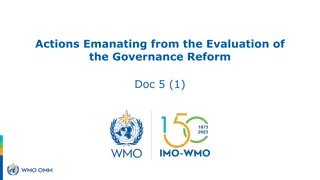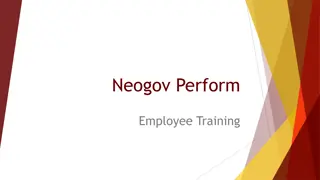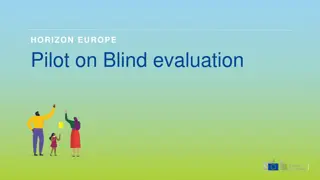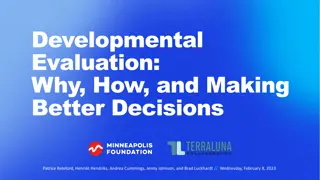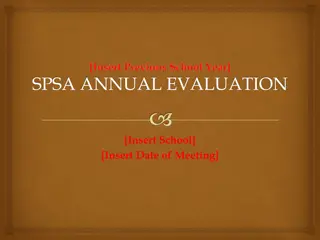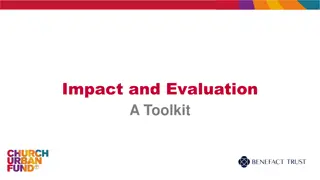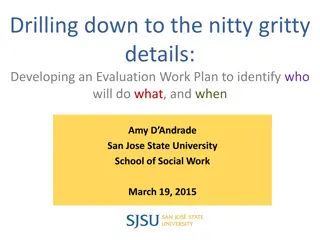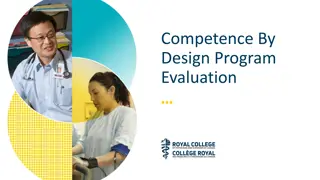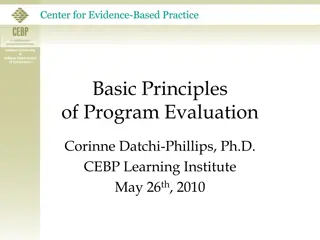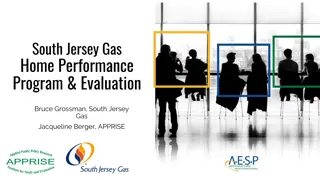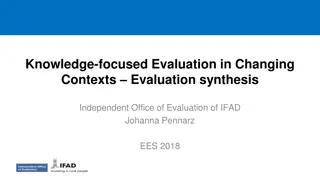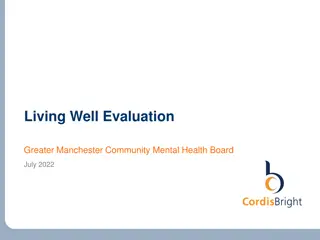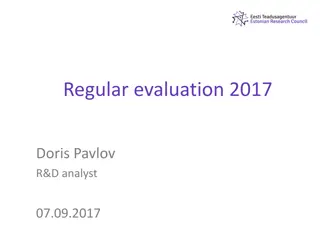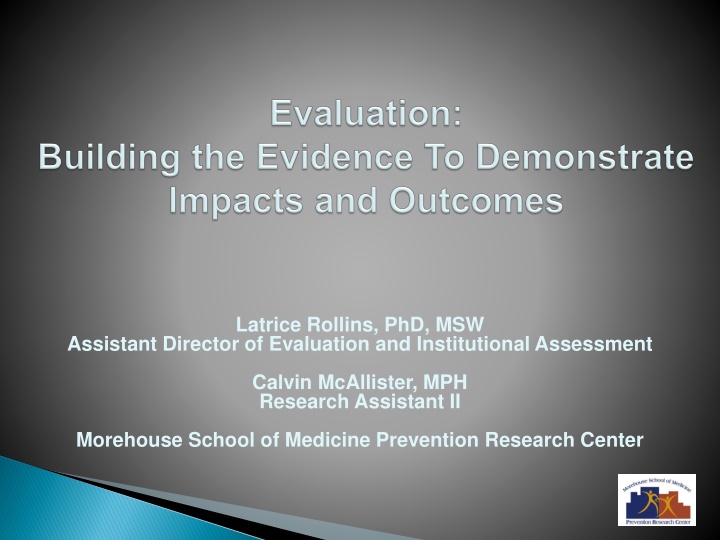
Comprehensive Overview of Program Evaluation Methods and Community-Based Approaches
Learn about program evaluation methods, including Community-Based Participatory Approach (CBPA), and the essential systems and infrastructure for successful community-academic partnerships. Explore examples and insights on improving program effectiveness, accountability, and generating new knowledge through evaluation practices.
Download Presentation

Please find below an Image/Link to download the presentation.
The content on the website is provided AS IS for your information and personal use only. It may not be sold, licensed, or shared on other websites without obtaining consent from the author. If you encounter any issues during the download, it is possible that the publisher has removed the file from their server.
You are allowed to download the files provided on this website for personal or commercial use, subject to the condition that they are used lawfully. All files are the property of their respective owners.
The content on the website is provided AS IS for your information and personal use only. It may not be sold, licensed, or shared on other websites without obtaining consent from the author.
E N D
Presentation Transcript
Latrice Rollins, PhD, MSW Assistant Director of Evaluation and Institutional Assessment Calvin McAllister, MPH Research Assistant II Morehouse School of Medicine Prevention Research Center
Describe evaluation Describe methods of evaluation Describe Community-Based Participatory Approach (CBPA) and the systems and infrastructure of community-academic partnerships necessary for CBPA Detail examples of CBPA to evaluation
Program evaluation is carefully collecting and analyzing information about a program or some aspect of a program in order to make necessary decisions about the program.
Improve the program Balancing the call to prove with the need to improve. (W.K. Kellogg Foundation) Determine program effectiveness Evaluation supports accountability and quality control Significant influence on program s future Generate new knowledge Not just research knowledge Determines not just that a program works, but analyzes how and why it works With whom is the program most successful? Under what circumstances? (W. K. Kellogg Foundation) 4
Funding is being provided as an investment toward the public good. This isn t a gift!! Funding agencies Federal, State, Public, Private if they fund you, there is an expectation of results Outcomes or funding. As a recipient of the funding you have the obligation to do your best to achieve the objectives of the research. Results are expected. This isn t a gift!! Outcomes or Impacts as funding. Impacts as a result of the a result of the Results are expected.
A participatory approach to evaluation is an evaluation that involves all the stakeholders in a project - those directly affected by it or by carrying it out - in every phase of evaluating it, and in applying the results of that evaluation to the improvement of the work.
Participatory monitoring and evaluation is not just a matter of using participatory techniques within a conventional monitoring and evaluation setting. It is about radically rethinking who initiates and undertakes the process, and who learns or benefits from the findings Institute of Development Studies, 1998
Participatory Participatory Traditional Traditional Who drives the evaluation? Community residents, project staff and other stakeholders Members of community groups, project staff and other stakeholders; evaluator Shared responsibility of evaluator and participating stakeholders Coach, facilitator, negotiator, criticalfriend Funders and program managers Who determines indicators of program progress? Professional evaluators and outside experts Who is responsible for data collection, analysis and preparing final reports? What is the role of the local evaluator? Professional evaluators and outside experts Expert, leader
It teaches skills that can be used in employment and other areas of life. It bolsters self- confidence and self- esteem in those who may have little of either. It encourages stakeholder ownership of the project. It can spark creativity in everyone involved. It encourages working collaboratively. It gives you a better perspective on both the initial needs of the project's beneficiaries, and on its ultimate effects. It can get you information you wouldn't get otherwise. It tells you what worked and what didn't from the perspective of those most directly involved - beneficiaries and staff. It results in a more effective project. It can provide a voice for those who are often not heard.
People's lives - illness, child care and relationship problems, etc. - may cause delays or get in the way of the evaluation. You may have to be creative about how you get, record, and report information. Funders and policy makers may not understand or believe in participatory evaluation. It takes more time than conventional process. It takes the establishment of trust among all participants in the process. You have to make sure that everyone's involved, not just "leaders" of various groups. You have to train people to understand evaluation and how the participatory process works, as well as teaching them basic research skills. You have to get buy-in and commitment from participants.
When you need information that it will be difficult for anyone outside the community or population to get. When part of the goal of the project is to empower participants and help them develop transferable skills. When you want to bring the community or population together. When you're already committed to a participatory process for your project. When you have the time, or when results are more important than time. When you can convince funders that it's a good idea. When there may be issues in the community or population that outside evaluators (or program providers, for that matter) aren't likely to be aware of.
All stakeholders, including: Participants or beneficiaries. Project line staff and/or volunteers. Administrators. Outside evaluators, if they're involved. Community officials. Others whose lives are affected by the project.
Mixed Method Approach including 2 or more of the following methods: Surveys Interviews Focus Groups Document Review Observations
Quantitative Numbers based on objectives and activities Types of data needed: Number of participants (process) Grade point averages (outcome) Retention rates (outcome) Survey data (outcome and process) Qualitative Narrative or text from: Interviews Focus groups Observations 14
Use when Use when You want information directly from a defined group of people to get a general idea of a situation, to generalize about a population, or to get a total count of a particular characteristic Many standardized instruments available Can be anonymous Allows a large sample Standardized responses easy to analyze Able to obtain a large amount of data quickly Relatively low cost Convenient for respondents Sample may not be representative May have a low return rate Wording can bias responses Close-ended or brief responses may not provide the whole story Not suited for all people e.g., low reading level Advantages Advantages Disadvantages Disadvantages
Use When Use When You want to understand impressions and experiences in more detail and be able to expand or clarify responses Advantages Advantages Often better response rate than surveys Allow flexibility in questions/probes Allows more in-depth information to be gathered Time consuming Requires skilled interviewer Less anonymity for respondent Qualitative data more difficult to analyze Disadvantages Disadvantages
Use When You want to collect in-depth information from a group of people about their experiences and perceptions related to a specific issue. Collect multiple peoples input in one session Allows in-depth discussion Group interaction can produce greater insight Can be conducted in short time frame Can be relatively inexpensive compared to interviews Requires skilled facilitator Limited number of questions can be asked Group setting may inhibit or influence opinions Data can be difficult to analyze Not appropriate for all topics or populations Advantages Disadvantages
Use When Use When Program documents or literature are available and can provide insight into the program or evaluation Data already exist Does not interrupt the program Little or no burden on others Can provide historical or comparison data Introduces little bias Time consuming Data Limited to what exists and is available Data may be incomplete Requires clearly defining the data you re seeking Advantages Advantages Disadvantages Disadvantages
Use when Use when You want to learn how the program actually operates its processes and activities Allows you to learn about the program as it is occurring Can reveal unanticipated information of value Flexible in the course of collecting data Advantages Advantages Disadvantages Disadvantages Time consuming Having an observer can alter events Difficult to observe multiple processes simultaneously Can be difficult to interpret observed behaviors
Theme in African American and Other Minority Communities: Coalition for Prevention Research Theme - - Risk Reduction and Early Detection
Established in 1998 Funded by the Centers for Disease Control and Prevention Ways of Engaging the community: Research, health promotions, evaluation, and DEFINING THE RESEARCH AGENDA! 22
The MSM PRC Community Coalition Board is comprised of: Community Residents Academic Institution Representatives Agencies within the City of Atlanta Neighborhood Planning Units T, V, X, Y and Z.
PRC Service Area City of Atlanta 420,003 Total Population 55,757 African American/Black 87% 52% Average Age 34.1 32.9 Average Household Income $34,389 $49,981 25
Bi-monthly meetings Scheduled social time and food at each meeting Formalized Structure and Governance
The bylaws permit a maximum of 25 board members, the majority must be community representatives. The board chair is always a community resident. All projects and protocols to be implemented by the PRC must be approved by the CCB s Project Review Committee, which consists of neighborhood representatives.
Research processes and outcomes benefit the community Community partners involved in analysis and interpretation of data and dissemination of results Partnerships to last beyond funded research Community empowered to initiate community-based research 1. 2. 3. 4.
Policies and programs based on mutual respect and justice Right to self-determination Community partners at every level Enforced principles of informed consent 10. Socially, culturally, environmental sensitive research and application 6. 7. 8. 9. Blumenthal DS. A community coalition board creates a set of values for community-based research. Preventing Chronic Disease 2006;3(1):A16.
The Pittsburgh Community Improvement Association in partnership with MSM PRC CCB, received funding from the DentaQuest Foundation to address the overwhelming need for African American males to increase their awareness of the importance of oral health.
Work with advisory board Conduct Oral Health Needs Assessment Assess the potential impact and capture important lessons learned throughout all aspects of health needs assessment process
Impact oral health care among African American males in Neighborhood Planning Units V, X, Y and Z through educational interventions that demonstrate the importance of oral health and its relationship to the overall quality of life through: Partnership development with health and community based organizations to provide oral health education. Conduct an oral health community education training and health resource sharing across the identified NPUs.
Policies and interventions to eliminate racial disparities in oral health should be directed at the social, physical and infrastructural characteristics of neighborhoods as well as individuals. Our results could be helpful for policy makers and NPUs citizen advisory councils in assisting the city in developing plans that best meet the needs of their communities. Education regarding access to dental care and insurance should be added to the curriculum.
Mean age-34.3 years old Average annual income - $39,720 28% of households are female-headed Source: profile. http://www.city- data.com/zips/30344.html. Source: City-data.com. (2010). Zip code detailed
Comprehensively include primary qualitative and quantitative data from community stakeholders and secondary data to identify the demographic profile, health needs, priorities demographic assets profile, health needs, priorities and assets Engage communities in the review and interpretation of what the data means in real- time Use community-based recommendations to guide service implementation
5 focus groups were conducted within 30344 to get community ideas and perceptions related to clinical care quality within 30344. A total of 47 participants (31 females, 16 males) All participants resided or were employed in 30344 and were 18 and older Consisted of community residents and workers, clinicians, and individuals with chronic diseases
The results of these focus groups helped to identify community preferences and recommendations to clinical care and supports Established a list of existing clinical assets within 30344 after review of the results from focus groups Developing an advisory committee
How might you apply one or more CBPA concept(s) to your work? What would be the added value of CBPA to your organization?

